

Margaret D. Jacobs, “A Generation Removed: The Fostering and Adoption of Indigenous Children in the Postwar World” (University of Nebraska Press, 2014) Margaret D.

Jacobs View on Amazon In 2012, a young Cherokee girl named Veronica became famous. A Tale of Woe and Glory by Thomas Powers. Infinity of Nations: Art and History in the Collections of the National Museum of the American Indian - George Gustav Heye Center, New York. Throughout North, Central, and South America, Native nations have often been guided by leaders recognized for their abilities to maintain reciprocal relationships and to coordinate collective efforts through their oratory and judiciousness.
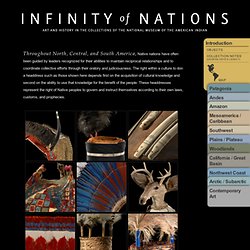
The right within a culture to don a headdress such as those shown here depends first on the acquisition of cultural knowledge and second on the ability to use that knowledge for the benefit of the people. These headdresses represent the right of Native peoples to govern and instruct themselves according to their own laws, customs, and prophecies. George Heye’s Legacy: An Unparalleled Collection The objects in this exhibition were largely collected by George Gustav Heye (1874–1957), a New Yorker who quit Wall Street to indulge his passion for American Indian artifacts. Edward Sheriff Curtis - an album on Flickr. Nancy Shoemaker, "Native American Whalemen and the World" (UNC Press, 2015) Native American People (First Nations and American Indian Cultures)
The Map Of Native American Tribes You've Never Seen Before : Code Switch. Aaron Carapella, a self-taught mapmaker in Warner, Okla., has designed a map of Native American tribes showing their locations before first contact with Europeans.
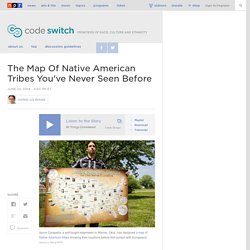
Hansi Lo Wang/NPR hide caption itoggle caption Hansi Lo Wang/NPR Aaron Carapella, a self-taught mapmaker in Warner, Okla., has designed a map of Native American tribes showing their locations before first contact with Europeans. Hansi Lo Wang/NPR. First Light — Upstander Project. Stories of the Ages: Graceful Heritage - The Five American Indian Ballerinas. By Jenefar De Leon, Staff Writer During a 1982 interview, American Indian ballerina Yvonne Chouteau spoke of how her heritage had enriched her dancing.
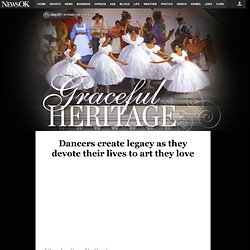
"The Indian people are very artistic as a whole," Chouteau was reported saying in a New York News Service interview. Zitkala-Sa photographed by Gertrude Käsebier, Zitkala-Ša, also known as Gertrude Simmons Bonnin,... Rosebud. Mourning Dove Soars: Celebrate the First Native Woman to Publish a Novel. She was taught to read with dime novels, and according to family legend was born in a canoe between 1884 and 1888.
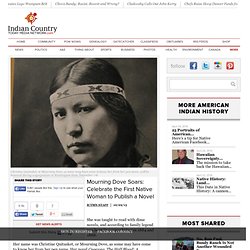
Her name was Christine Quitasket, or Mourning Dove, as some may have come to know her from her pen name. Her novel Cogewea, The Half Blood: A Depiction of the Great Montana Cattle Range, was the first to be published by a Native American woman. The book is about a mixed-blood girl caught between white ranchers and reservation Indians—“the book combines authentic Indian lore with the circumstance and dialogue of a popular romance,” says a description on Amazon.com. “Cogewea is a young, spirited, mixed-blood woman who has returned to her brother-in-law’s ranch in Montana from the Carlisle Indian school. According to HistoryLink.org, she told a Spokane newspaper in 1916 that she wanted to break down white stereotypes of American Indians.
That article advertised the release of Cogewea, but the book wouldn’t actually be published until 1927. Cherokee_blood_why_do_so_many_americans_believe_they_have_cherokee_ancestry. Photo courtesy Carol M.
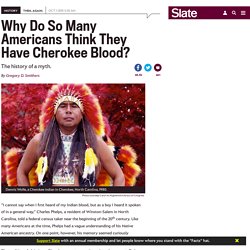
Hitler’s Inspiration and Guide: The Native American Holocaust. While attending the annual Garifuna Film Festival held here in Los Angeles, we watched films about indigenous cultures, and saw the 1985 Academy Award-winning documentary Broken Rainbow, directed by Victoria Mudd, which discusses the history of injustice towards the Native American people.

The film talked about The Long Walk of the Navajo, which was the 1864 deportation and attempted ethnic cleansing of the Navajo people by the U.S. government. 8,000 Navajos were forced to walk more than 300 miles at gunpoint from their ancestral homelands in northeastern Arizona and northwestern New Mexico to an internment camp in Bosque Redondo, which was a desolate tract on the Pecos River in eastern New Mexico. Many died along the way. From 1863 to 1868, the U.S. Military persecuted and imprisoned 9,500 Navajo (the Diné) and 500 Mescalero Apache (the N’de). Planting Truthful Seeds About Native Americans. “The truth about stories is that that’s all we are.”

–Thomas King, The Truth About Stories Current K-12 teaching about Native Americans tends to focus solely on the past—the long-dead past. This gives students the impression that Native peoples no longer exist and the treatment of their cultural practices and symbols are fair game for misappropriation, disrespect and abuse. Native American Actors Work to Overcome a Long-Documented Bias.
Photo Late in April, after Native American actors walked off in disgust from the set of ’s latest film, a western sendup that its distributor, Netflix, has defended as being equally offensive to all, a glow of pride spread through several Native American communities.
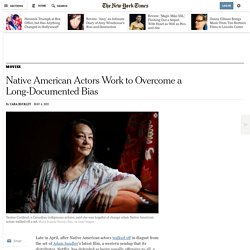
Tantoo Cardinal, a Canadian indigenous actress who played Black Shawl in “Dances With Wolves,” recalled thinking to herself, “It’s come.” Larry Sellers, who starred as Cloud Dancing in the 1990s television show “Dr. Quinn, Medicine Woman,” thought, “It’s about time.” Jesse Wente, who is Ojibwe and directs film programming at the TIFF Bell Lightbox in Toronto, found himself encouraged and surprised. But what didn’t surprise Mr. The walkout prompted a rhetorical “What do you expect from an Adam Sandler film? Manning: Native American Heritage Month: 6 Tips for Educators, Parents.
On October 30, 2015, President Obama proclaimed the month of November as Native American Heritage Month.
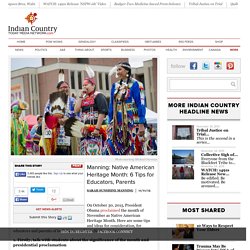
Here are some tips and ideas for consideration, for educators and parents of both Native and non-Native students. 1. Madness Radio: Indian Country Psychology David Walker. The Human Cost of Keystone XL - Pacific Standard. In a Montana Greyhound station, Annita Lucchesi, a 24-year-old Southern Cheyenne woman, noticed an entire wall filled with photos of missing women.
“The majority of them were native women and it broke my heart,” she says. Lucchesi works for the National Indigenous Women’s Resource Council. Because of her job, she knew that human trafficking around North Dakota’s Bakken oil fields was on the rise. But this wall was a visualization of the numbers she and her colleagues dealt with every day. In her office they were statistics; here they were her sisters. Lucchesi pulled out her phone and began snapping photos of the posters to share on social media. Boomtowns are rarely safe spaces for women. “They were saying, ‘Oh yeah, North Dakota is the fucking best; in North Dakota you can take whatever pretty little Indian girl that you like and you can do whatever you want and police don’t give a fuck about it,’” Lucchesi says. Princeton Alumni Weekly.